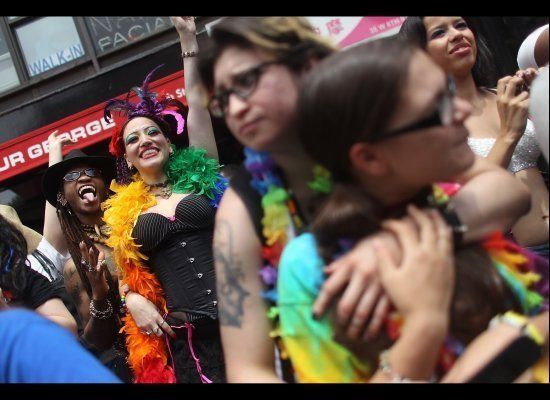
There it was, staring right out at me Monday morning when I got to my office in midtown Manhattan: Page 1 of the local section of The Wall Street Journal had a large photo from Sunday's Pride parade down Fifth Avenue. It took up a lot of real estate on that page, so that alone was surprising. The parade marking the anniversary of the 1969 Stonewall uprising, now in its 43rd year, wasn't particularly newsworthy. But what surprised me most was the photo they chose: men and women marching together, varied ages and ethnicities, dressed in everyday casual attire, with the headline "Under the Rainbow in New York City."
The traditional media aren't the gatekeepers they were just a decade ago. But the influence they have on the masses is still huge. And while some might argue that we've already transitioned to a post mass-media world of news delivery and consumption, stumbling across news when not looking for it opens people's eyes to things they may have been blinded to by mere naïveté or ignorance.
It's one thing to go looking for news and another to have it served up to you on request. We set our alerts to notify us when our favorite news sources or columnists post another story. We might click on a link that shows up in a friend's post in a Facebook news feed. But then we're seeking out the stories we want to read, often from the viewpoints we want to hear.
Rush Limbaugh's audience is already sold on his point of view. They just want to hear it again. And again and again. They're not looking to be exposed to a different point of view. They want to hear their own opinions validated and reinforced. I can't say I was much different when I enjoyed Keith Olbermann's nightly rants on MSNBC. You're probably here on The Huffington Post secure in the knowledge that you'll find something on a topic that's already of interest.
That's why the kind of coverage that gay voices receive on the conservative pages of The Wall Street Journal is so important for us to continue to make progress in securing equal rights and making it safe for LGBT young people in their communities, schools, and their own families.
In the 1960s I was in middle school (then called "junior high school"), trying to understand why it was the guys I was daydreaming about in class instead of the girls. Already a voracious reader, I used to go through the daily newspaper with my parents at the breakfast table and watch the nightly news on TV. There we'd hear the terrible stories about "homosexuals": They had been caught molesting children, having sex in public rest areas, or dead in some back alley.
There are still Jerry Sanduskys out there, but at least now there's a balance, and anyone reading most mainstream media will see plenty of examples of healthy, well-adjusted, successful gay men and women in politics, the arts, business, and just about every other field. Back then, every news story was terrible: The only time most Americans ever heard about gay people was when they were on their way to jail or the morgue. Even the most enlightened folks would have had a hard time identifying any gay men they knew who weren't hairdressers or florists (not that there's anything wrong with that!). Everyone else was in the closet. They were married or had their "girlfriends" readily at hand for any family occasion or business dinner.
That's why the photo in this week's Wall Street Journal means a lot. All those people who came across it spread across the section's front page saw gay men and women who probably didn't look too different from the folks in the next cubicle.
I used to cringe when I looked at the newspapers and magazines the week after Pride to see the photos they carried, questioning whether they hurt our cause more than they helped. And you don't have to go back very far to see why: Even The New York Times' coverage of the 2005 Pride march featured a photo of women with cowboy hats on motorcycles and, below that, a shirtless guy with a feathered headdress.
It's perceived difference that demonizes, and once that's gone, it's tougher to justify bullying and the denial of basic equal rights. So bravo to The Wall Street Journal editor who chose that photo, because images matter a lot. And that's especially true for those who come across them without looking for them.
